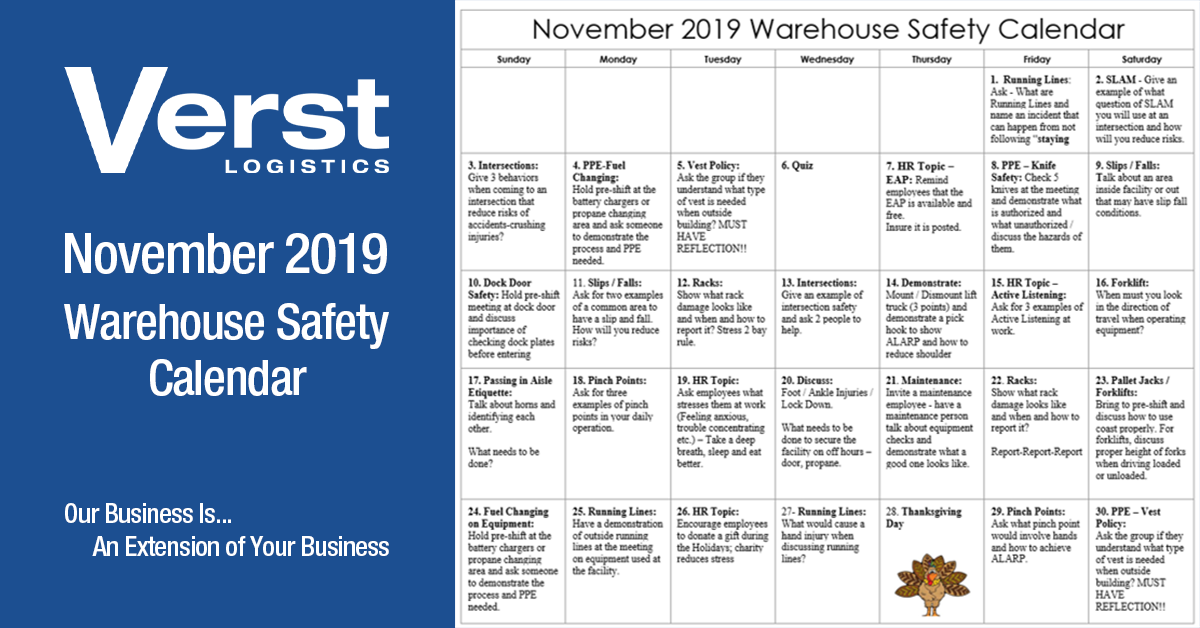
July 30, 2019
Warehouses are statistically one of the most dangerous places to work, and the added tasks of operating heavy machinery and transporting large objects do not make it safer. In 2017, there were approximately 209,000 non-fatal occupational injuries in the transportation and warehousing industry in the private sector according to the U.S. Bureau of Labor. The even bigger number is the days away from work that still costs company's money when the employee isn't present. In 2017 alone, there were over 20,000 days away from work related to injuries by warehouse workers.
Click to Download the August 2019 Warehouse Safety Calendar
 Warehouse injuries are extremely expensive, and needless to say because of this, warehouse safety is extremely important. The even bigger reason to focus on safety is the well-being of your employees - they need to come first. There are many things you can do to avoid workplace accidents and to maintain a safe workplace for your employees and the environment. It is important to establish a proper safety protocol, conduct regular safety training, follow long-term and short-term housekeeping procedures, and have the proper safety products and equipment.
Warehouse injuries are extremely expensive, and needless to say because of this, warehouse safety is extremely important. The even bigger reason to focus on safety is the well-being of your employees - they need to come first. There are many things you can do to avoid workplace accidents and to maintain a safe workplace for your employees and the environment. It is important to establish a proper safety protocol, conduct regular safety training, follow long-term and short-term housekeeping procedures, and have the proper safety products and equipment.
Please use this monthly safety calendar to go over topics with your employees that will allow your managers to establish proper warehouse safety protocol and conduct regular daily and monthly warehouse safety training schedules.
Please use our monthly warehouse safety calendar below as a guide for your safety meetings.
August 2019 Warehouse Safety Calendar |
||||||
| Sunday | Monday | Tuesday | Wednesday | Thursday | Friday | Saturday |
| 1 | 2 | 3 | ||||
|
Overhead Doors: Name two injuries that could happen while working around an overhead door. |
Question: Tell me why you never park equipment on a dock plate. |
Foot / Ankle Injuries: Do a demonstration of site specific Foot/Ankle injury. Discuss reducing risks. |
||||
| 4 | 5 | 6 | 7 | 8 | 9 | 10 |
|
Question: What does palms up mean when opening overhead doors? |
Cuts / Knives: Show me the authorized knives that can be used at this site. |
PPE/Signage: Bring 2 types of PPE to the meeting and talk about expectations and inspecting. Show a pinch point and/or a sign -site specific. |
Pinch Points: Name two pinch points that are on pallets and conveyors that could injure you. |
Question: What would you do if you saw someone struggling and not sweating? |
Three Points of Contact: Show 3 point entry and exiting off equipment. |
Question: Will drinking Monster drinks help with hydration? No, they actually make it worse, drink water instead. |
| 11 | 12 | 13 | 14 | 15 | 16 | 17 |
|
Reporting Incidents: Ensure all employees understand to report all incidents immediately |
Workplace Violence: What do you do if you see a person with no vest and no escort? |
Lock Out Tag Out (LOTO): Tell me what the cone policy is (site specific) |
Use Quiz |
Fatal Risks: Ask the group what are they and why? What do we do to reduce risks? |
Seat Belts: Tell me why we must wear a seat belt. |
Foot Injuries: What are two ways you will reduce the risk of foot injuries today? |
| 18 | 19 | 20 | 21 | 22 | 23 | 24 |
|
Intersections: What are two things you must do to be safe when entering an intersection. |
Pallet Safety: What are two injuries that could happen while working with pallets. |
Hydration: What’s the hydration formula? |
Emergency Stops: Talk about location of E-stops and when to use. |
Question: Tell me why you never park equipment on a dock plate. |
Hand Injuries: Name two ways you could injure your hand and how you will reduce your risks. |
Powered Equipment Hazards: Ask a couple employees to demonstrate 1 hazard on powered equipment. |
| 25 | 26 | 27 | 28 | 29 | 30 | 31 |
|
Evacuations: Ask what alarms are and meeting areas. Walk to exits. fire and tornado, etc. |
Foot / Ankle Injuries Discuss site-specific injuries (coaster, seat belt, mount / dismount) |
Cuts / Knives: Show knifes that are acceptable and always cut away from body. |
SDS: Bring an SDS to the meeting and discuss the information that can be used. |
Running Lines: Have someone at the meeting show the running lines on two pieces of equipment. |
Fingers / Hands Pinch Points: Ask how this type of injury can happen. |
Two-Bay Rule: Tell me what the 2-bay rule is and why we use it. HMA: 40 feet |
Tags:

Warehouses are statistically one of the most dangerous places to work, and the added tasks of operating heavy machinery and transporting large objects do not make it safer. In 2017, there were...
Resources
Connect